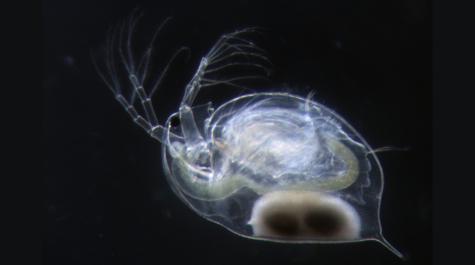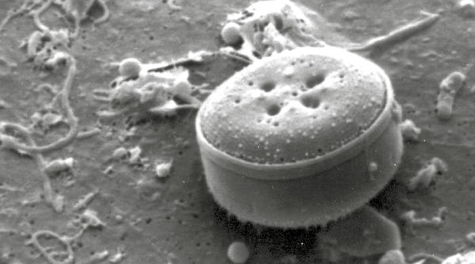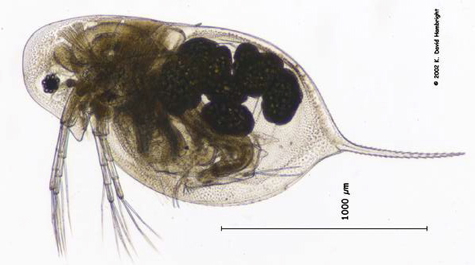Study shows that hitchhiking bacteria can go against the flow
—Augustus De Morgan
A new study co-authored by professor Kam Tang of the Virginia Institute of Marine Science reveals that tiny aquatic organisms known as "water fleas" play an important role in carrying hitchhiking bacteria to otherwise inaccessible lake and ocean habitats.
The article, "Bacteria dispersal by hitchhiking on zooplankton," appeared in the June 29 issue of the Proceedings of the National Academy of Sciences. It was co-authored by scientists from the Leibniz-Institute of Freshwater Ecology and Inland Fisheries in Stechlin, Germany.
Bacteria and other microorganisms are key components of aquatic ecosystems, nurturing the base of the food web and recycling organic matter into carbon, nitrogen, and other elemental constituents of global biogeochemical cycles. Some, like Vibrio, can cause disease. Vibrio is responsible for cholera and other water- and shellfish-borne illnesses.
Aquatic microbes are also some of the most abundant, widespread, and diverse organisms on Earth. Scientists estimate that a single tablespoon of seawater holds 5 million marine bacteria, and that a liter can hold tens of thousands of microbial species. Aquatic microbes occur from the deep seafloor to polar lakes, and pretty much everywhere in between.
Yet despite their ubiquity throughout aquatic ecosystems, Tang says the manner by which microbes move from one habitat to another has been somewhat of a mystery. That's because for animals of this small size, water has the viscosity of honey, and the boundary between water masses of different temperature and salinity may as well be a brick wall.
Previous studies have shown that wind, birds, and land animals can help carry aquatic bacteria from lake to lake, and that bacteria can spread quickly through a particular water mass simply by dint of their extremely rapid growth rates. Earlier studies also show that bacteria can move downward with the larger, heavier particles of organic detritus that constantly rain upon the seabed.
Testing the conveyor-belt hypothesis
The study by Tang and his colleagues sought to test an alterative means of bacterial dispersal—their "conveyor-belt" hypothesis that bacteria might also be able to move upward, against gravity and across stratified density boundaries, by hitching a ride with the many zooplankton species that migrate from the depths to the surface each day with the setting sun. Their idea requires that bacteria not only climb aboard the upwardly migrating zooplankton, but that they later disembark in surface waters. Another possibility is that zooplankton eat the bacteria, and later egest them unharmed.
Tang says that intermittent or permanent stratification due to differences in temperature and salinity is common in many water bodies, whether they be lakes, coastal bays, or the open ocean. Stratification occurs frequently in Chesapeake Bay and other estuaries when relatively fresh river water forms a layer that floats atop the saltier, denser seawater entering the estuary's mouth.
To test their hypothesis that bacteria might be moving between water masses by hitching a ride on "water fleas" like Daphnia, the researchers filled a series of graduated cylinders with fresh- and then salt-water to form a stably stratified water column, then added bacteria labeled with a green fluorescent protein to the lower layer and kept the top layer bacteria-free.
The researchers then added Daphnia to the cylinders and used a directed light source to manipulate their swimming direction. (The species of Daphnia they used instinctively move toward light.) By alternating the position of the light every 2 hours for 8 hours, the researchers were able to make the water flea swim up and down across the stratified water column several times, and followed the rate at which bacteria were transported upward. A cylinder with bacteria but without Daphnia served as the control. Afterward, the experiment was repeated by adding bacteria to the top layer of the cylinders and following the downward transport of the bacteria by migrating Daphnia.
The experiments were done with 3 different species of bacteria. At the end of their lab experiments, the team found labeled bacteria were transported in both upward and downward directions in the cylinders containing Daphnia, confirming their "conveyor-belt" hypothesis. Field studies of Daphnia and bacteria from a local lake further strengthened their laboratory findings.
Aquatic hitchhikers
The team's study, says Tang, clearly shows that "bacteria, including pathogens, are able to travel and cross aquatic boundaries by hitchhiking on migrating organisms, thus facilitating exchanges between separate microbial communities and allowing access to otherwise inaccessible resources."
The authors note that "unlike slowly sinking aggregates and other detritus that mostly transport bacteria downward, mobile and migrating hosts can cover long distances rapidly and disperse bacteria in all directions repeatedly and effectively."
Tang cautions that in natural environments with diverse species of zooplankton, "dispersal of hitchhiking bacteria will not be uniform and can occur both vertically and horizontally, and on different time and space scales, from daily to seasonal migrations over millimeters to kilometers."
Although the team conducted their study in freshwater lakes and with freshwater organisms, Tang says their findings likely pertain to ocean ecosystems as well. "Many species of marine zooplankton migrate long distances vertically on daily or seasonal time scales, or during different stages of their life cycle," he says. "They may therefore transport and disperse bacteria over long distances, affecting the ecology and physiology of even deep-sea microbes."



